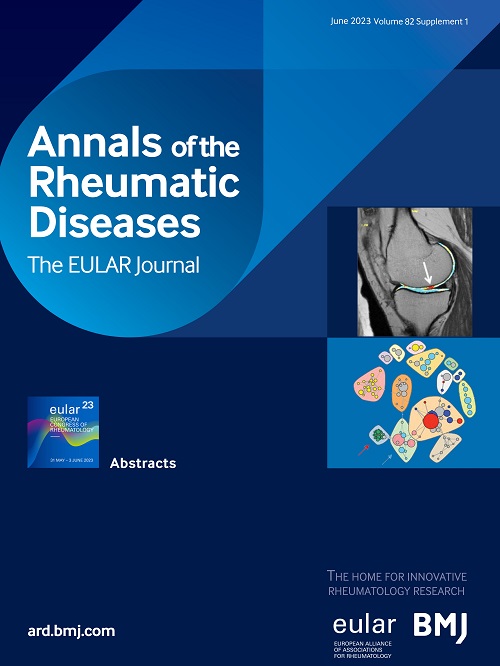Sle患者对医疗服务提供者和医疗计划的评分与医疗技术质量相关吗?
IF 20.3
1区 医学
Q1 RHEUMATOLOGY
引用次数: 0
摘要
先前的研究表明,SLE护理的技术质量与随后累积损伤的程度有关。然而,尚不清楚患者与提供者和卫生系统之间相互作用的性质是否与护理的技术质量有关。目的:我们评估患者对与医疗服务提供者和卫生系统互动的评分与医疗技术质量之间的关系。方法:我们分析了来自UCSF狼疮结局研究(LOS)的数据,这是一个每年通过电话采访的全国性狼疮患者样本。该调查包括由美国医疗保健研究和质量机构开发的消费者健康计划评估(CAHPS)和护理人际过程量表(IPC)2中的单元,从0-100分对提供者(患者-提供者沟通,共同决策,信任)和卫生系统(护理的及时性/及时性,护理协调,健康计划评估)的6个方面进行护理评分。由于评分不是正态分布,我们将最低和最高的三个四分位数进行了二分类。调查还包括SLE患者可可靠报告的13个质量指标(QIs) 3。qi被汇总成通过率,定义为收到的qi数量占个人合格数量的比例。我们使用广义估计方程来模拟QI合格率与处于每个维度评级的最低四分位数以及在维度的0,1 -3和4-6中处于最低四分位数之间的关系。模型根据年龄、种族/民族、教育程度、贫困状况、健康保险的存在和种类、主要SLE医师的专业、病程、疾病活动性(SLAQ)和损害(BILD)4进行了调整。结果640名在前一年拜访过主要SLE提供者≥1次的LOS参与者符合分析条件。平均年龄52.8±12.6岁,平均病程20.1±8.8年;其中38%为非白人,14%为贫困人口。在任何一个维度的评分中处于最低四分位数与QI合格率的统计学显著差异无关(表1)。在4-6个维度的评分中处于最低四分位数与显著较低的合格率相关(0.63比0.71,对于没有维度的最低四分位数,p=0.02;表2).结论:在相互作用的多个维度上的低评分可能是低技术护理质量的哨兵。在美国,提供者和健康计划的评级是公开的,这些信息可以帮助SLE患者选择提供者和健康计划,更有可能实现高技术质量的护理。叶林,叶林。系统性红斑狼疮患者护理质量对疾病预后的影响。关节炎与风湿病2013;[6]张建军,李建军,李建军,等。不同人群中护理的人际过程。Milbank Quarterly 1999;[37]张建军,张建军,张建军,等。系统性红斑狼疮的护理质量:应用质量措施了解护理差距。J Gen Intern Med 2012 Yazdany J, Trupin L, Gansky SA,等。狼疮损伤简要指数(BILD):患者报告的SLE损伤测量。关节炎护理与研究2011;利益披露:未申报DOI 10.1136/ annrheumatdis -2014-eular.2953本文章由计算机程序翻译,如有差异,请以英文原文为准。
THU0445 Are Patient Ratings of Providers and Health Plans Associated with Technical Quality of Care in Sle?
Background Prior research has shown that the technical quality of SLE care is associated with the degree of subsequent accumulated damage1. However, it is not known whether the nature of interactions between patients and providers and health systems is associated with the technical quality of care. Objectives We evaluated the relationship between patient ratings of interactions with providers and health systems and the technical quality of care. Methods We analyzed data from the UCSF Lupus Outcomes Study (LOS), a national sample of persons with SLE interviewed annually by telephone. The survey includes batteries from the Consumer Assessment of Health Plans (CAHPS) developed by the US Agency for Healthcare Research and Quality and the Interpersonal Processes of Care Scales (IPC)2 to rate care along 6 dimensions about providers (patient-provider communication, shared decision-making, trust) and health systems (promptness/timeliness of care, care coordination, assessment of health plans) from 0-100. Because the ratings were not normally distributed, we dichotomized the measures at the lowest versus the highest three quartiles. The survey also includes the 13 quality indicators (QIs) for SLE that can be reliably reported by patients3. The QIs were aggregated into a pass rate, defined as the number of QIs received as a proportion of those for which individuals are eligible. We used generalized estimating equations to model the relationship of the QI pass rate with being in the lowest quartile of ratings of each dimension and with being in the lowest quartile on 0, 1-3, and 4-6 of the dimensions. Models were adjusted for age, race/ethnicity, education, poverty status, presence and kind of health insurance, specialty of principal SLE physician, disease duration, disease activity (SLAQ), and damage (BILD)4. Results 640 LOS participants with ≥1 visit to their principal SLE provider in the prior year were eligible for analysis. Mean age was 52.8±12.6 years and mean disease duration was 20.1±8.8 years; 38% were non-whites, and 14% were in poverty. Being in the lowest quartile of ratings on any one individual dimension was not associated with a statistically significant difference in QI pass rates (Table 1). Being in the lowest quartile of ratings on 4-6 dimensions was associated with significantly lower pass rates (0.63 vs. 0.71 for those in the lowest quartile on no dimensions, p=0.02; Table 2). Conclusions Low ratings on multiple dimensions of interactions may be a sentinel for poor technical quality of care. In the US, ratings of providers and health plans are in the public domain and this information can help persons with SLE choose providers and health plans more likely to achieve high technical quality of care. References Yazdany J TL, Katz P, Schmajuk G, Yelin E. Quality of Care Predicts Disease Outcomes among Patients with Systemic Lupus Erythematosus. Arthritis & Rheumatism 2013; 65:S1135 Stewart A, Napoles-Springer A, Perez-Stable E, et al. Interpersonal processes of care in diverse populations. Milbank Quarterly 1999; 77:305-339 Yazdany J, Trupin L, Tonner C, et al. Quality of Care in Systemic Lupus Erythematosus: Application of Quality Measures to Understand Gaps in Care. J Gen Intern Med 2012 Yazdany J, Trupin L, Gansky SA, et al. The Brief index of lupus damage (BILD): A patient-reported measure of damage in SLE. Arthritis Care & Research 2011; 63:1170-1177 Disclosure of Interest : None declared DOI 10.1136/annrheumdis-2014-eular.2953
求助全文
通过发布文献求助,成功后即可免费获取论文全文。
去求助
来源期刊

Annals of the Rheumatic Diseases
医学-风湿病学
CiteScore
35.00
自引率
9.90%
发文量
3728
审稿时长
1.4 months
期刊介绍:
Annals of the Rheumatic Diseases (ARD) is an international peer-reviewed journal covering all aspects of rheumatology, which includes the full spectrum of musculoskeletal conditions, arthritic disease, and connective tissue disorders. ARD publishes basic, clinical, and translational scientific research, including the most important recommendations for the management of various conditions.
 求助内容:
求助内容: 应助结果提醒方式:
应助结果提醒方式:


